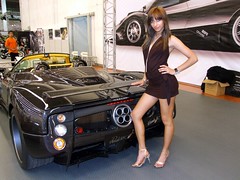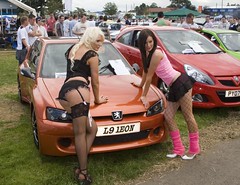Mazda MX-5 Roadster Review; 900,000 Vehicles Sold Later
The favourite car of 800,000 or so hairdressers since it first appeared in 1989, the 900,000th Mazda MX-5 Miata rolled off the Mazda assembly line over in Japan recently. I suppose the remaining 100,000 were bought by motoring enthusiasts. But jokes aside, this little open top sports car managed to capture the spirit of classic British open top motoring. It heralded a second coming for affordable open top motoring and is actually what a small roadster should be – light, agile and mechanically uncomplicated.
It has been debated that the Miata is more British than the current crop of British sports cars. Imagine that, the quintessential British sports car is Japanese. Anyway, what better way to celebrate this milestone by featuring one right here on CarThrottle. A third generation NC series JDM spec Mazda MX-5 ‘Roadster’ from 2005. But, before I start telling you readers out there how this car actually drives lets go back down memory lane for a brief overview of the MX-5.
It all started in the 1980s when no one was actually building proper roadsters. None of the major manufacturers in Europe were producing small open top sports cars like they used to do eight or nines years earlier. In the late 1970s up to 1980 British Leyland via MG produced the MGB Roadster. The only other convertible that carried on after that was the horrid looking ‘ultra wedge’ Triumph TR7 convertible and this was considered to be something totally weird and not really that cool to have. Only Alfa Romeo soldiered on with the Alfa Spider through the 1980s and early 1990s which by then was totally ancient. You can’t blame Alfa Romeo for continuing the Spider way past its sell date as it was a good looking roadster. But it was Italian. This meant that its electrics had a mind of its own and it would sometime decide to go on strike more often than some labor unions would.
Anyway, somehow someone in Mazda must have felt extremely nostalgic about those small, tiny British roadsters especially the Austin Healey Sprite and the Lotus Elan. This person convinced the management of Mazda to come out with a small affordable front engined, rear drive roadster in the mold of those British Roadsters from the 1960s. After nearly a decade of research and development, the MX-5 was launched in 1989. It had a 1.6-litre engine and only weighed 940kg back then. This enabled the MX-5 to hit sub 8 second 0-100km/h (0-62mph) times and a top speed of 210km/h or 130mph. Pretty decent times even for today.
This first generation MX-5 was called the ‘NA’ series. A good 400,000 units of it were sold from 1989 to 1997 and in 1998 the second generation, slightly heavier 1.8-litre (also with a cut price 1.6-litre version) NB model was launched. This model soldiered on to 2005 where the third generation NC model was launched with a 2.0-litre engine and it was also much heavier than the previous models (1,100kg on average). This happened due to increased safety equipment (which included traction control, that could be switched off, for the first time) but on average, the MX-5 was still much lighter than most contemporary sports cars. Well, bar the Lotus Elise, which isn’t a traditional roadster in the first place.
The 2005 MX-5 Roadster I tried was a low mileage gray import from Japan and was only recently registered over here in Malaysia. It had 10,000km on the clock when I tried it and it felt like it. Everything was taut and precise. There were no rattles or squeaks throughout the drive and the interior was surprisingly very well built. The tan leather complimented the dark colored plastic fittings and Onyx wood trim on the dashboard. Oooo…Onyx. Something people in the Cotswolds would love. The quality of materials used was also surprising. It felt very tactile to the touch and the quality was high. If you stepped out from a 2006 BMW Z4 and into this you wouldn’t be disappointed (If you stepped in from an Audi TT then it would be a different question – it basically shows that the BMW’s interior isn’t all that great in the first place).
The 2.0-litre engine produces 170bhp and around 190Nm (140lb/ft) of torque. It is a responsive powerplant but sounds and feels agricultural. Somehow Mazda 4-cylinder engines are like this. I remember driving quite a fair number of Mazda 323 Familias from the late 1980s and the 1990s which basically felt coarse sounding. However this being a 2005 car it was slightly surprising. But in this Mazda the engine does its job well. This car was coupled with the optional 6 speed automatic transmission and it was very sprightly. The automatic holds up to the redline and shifts quickly. And if you use the steering mounted pedal shifters you still have some semblance of control, especially when you’re downshifting before a corner. I feel that Mazda’s 0-60mph estimate of 7.9 seconds is an understatement. This car is clearly a low 7 second car to 60mph after gunning it a couple of times.
The car somehow really does feel like a British roadster. I for one should know as last November I happened to clock over 200 kilometers in a 1954 MG TF 1500 Roadster. It somehow shares the distinct DNA of the old girl in feel. The light, agile feeling from the old British roadster is carried over into the MX-5. Even the driving position is low and ergonomically suited to my physique. Direction changes in the MX-5 are sweet. It is a very nimble car and with good steering feel. Some may have complained that the current crop of MX-5s do not have as much steering feel as the older cars but if you compare the MX-5 with other contemporary sports coupes, hot hatches or rally specials that populate the performance car market you will find that the MX-5′s steering is still pure and direct. I remember driving a Nissan 350Z a while back and I felt that I did like how the steering felt and I also remember driving Lancer Evolutions that had really good steering feel for an all-wheel drive but the MX-5 still felt purer in feel. This isn’t something about steering accuracy, but just purely on feel. Something that isn’t really quantifiable.
So the engine is sweet, the steering is nice and these two items make driving the car better. The car feels so small and light compared to other, mostly heavier, performance cars out there in the market these days. After getting used to the car’s very nimble ways it is easy to steer into a sharp bend at higher than usual speeds. You have a responsive and planted front end and a very agile rear in the MX-5. And the fact that you’re sitting almost on top of the rear axle makes you actually know how its going to react. If you punt it into a corner it just turns in and the rear assists with a gentle nudge in the right direction. No I didn’t push it into an oversteer or anything like that this time around as traffic didn’t permit it. I merely drove it as the traffic permitted but took the corners with added gusto to get a better feel of the car (I was as fast round the bends as on the straights). The ride is also pretty good and it wasn’t harsh or choppy. Although sometimes the tail may step out where there are dips and crests, much like how roadsters did in the good old days.
I actually liked this current MX-5. The car looks very up-to-date and current especially with the factory fitted bodykit option. More Mazda RX-8 in terms of looks too. With the 2.0-litre engine it does feel easily at ease at speeds above the ton compared to the older models. Although some may have complained that it isn’t as pure as the earlier versions I beg to differ. More RX-8 sports car-like instead of British roadster-like they may say. Yes it does have added refinement and I think that is a good thing. It may supposedly lack steering feel and response of the older models but compared to what you get to drive these days it is still magical. You still sit lower than the RX-8 and you still sit close to the rear axle that this MX-5 does not feel like you’re driving a RX-8 or any other large Japanese sports car (like the Nissan 350Z or the sort). It is therefore a traditional British roadster in every sense except that it is made thousands of miles from where the concept originated from.
So there you have it. A short write up on a car that over a period of 12 years sold close to a million cars and one which I hope will continue to uphold the virtues of affordable and fun open top motoring for generations to come.




















